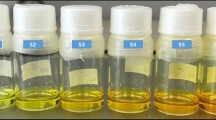Abstract
In this study, the impacts of doping concentration on the crystal structure, morphology, electrical, and optical properties of Ho3+-doped zinc oxide (ZnO) nanorod (NR) arrays were studied. Structural and morphological characterizations showed that the Ho3+-doped ZnO NRs were crystallized in the (002) direction, and that they had a homogeneous distribution on the substrate. The crystallite sizes of the samples were between 50 nm and 65 nm. SEM analysis showed that every sample was hexagonal in shape. For the 1 and 5 mol.% Ho3+-doped ZnO NRs, the values for electrical conductivity were found to be 1.41 × 10−7 and 8.29 × 10−6 (Ω cm)−1 at 25°C and 1.70 × 10−5 and 1.24 × 10−3 (Ω cm)−1 at 300°C, respectively. The optical transmittances were between 80 and 93% for all the samples in the region from 400 to 1000 nm. The optical band gap values were determined to be between 3.180 and 3.195 eV.





Similar content being viewed by others
References
B.G. Lewis and D.C. Paine, MRS Bull. 25, 22 (2011).
D.S.Y. Jayathilake and T.A. Nirmal Peiris, SF. J. Mater. Chem. Eng. 1, 1004 (2018).
C.G. Granqvist and A. Hultaker, Thin Solid Films 411, 1 (2002).
T. Minami, Thin Solid Films 516, 1314 (2008).
A.A. Janotti and C.G. Van de Walle, Rep. Prog. Phys. 72, 126501 (2009).
V. Kumari, V. Kumar, B.P. Malik, R.M. Mehra, and D. Mohan, Opt. Commun. 285, 2182 (2012).
R.A. Mereu, A. Mesaros, M. Vasilescu, M. Popa, M.S. Gabor, L. Ciontea, and T. Petrisor, Ceram. Int. 39, 5535 (2013).
A. Hastir, N. Kohli, and R.C. Singh, J. Phys. Chem. Solid. 105, 23 (2017).
H.Y. He, J. Fei, and J. Lu, J. Nanostruct. Chem. 5, 169 (2015).
P. Pandey, R. Kurchania, and F.Z. Haque, Opt. Spectrosc. 119, 666 (2015).
A. Albert Manoharan, R. Chandramohan, K. Deva Arun Kumar, S. Valanarasu, V. Ganesh, M. Shkir, H. Algarni and S. AlFaify, J. Mater. Sci. Mater. Electron. 29, 13077 (2018).
M. Zafar, B.S. Kim, and D.H. Kim, Mater. Chem. Phys. 240, 12207 (2020).
H. Çolak, J. Mater. Sci. Mater. Electron. 26, 784 (2015).
H. Çolak and E. Karaköse, J. Rare Earth 36, 1067 (2018).
H. Çolak and E. Karaköse, Mater. Sci. Semicond. Process. 101, 230 (2019).
S. Singh, J.N. Divya Deepthi, B. Ramachandran and M.S. Ramachandra Rao, Mater. Lett. 65, 2930 (2011).
M. Akyol, A. Ekicibil, and K. Kiymaç, J. Supercond. Nov. Magn. 26, 3257 (2013).
A. Ekicibil, Solid State Sci. 14, 1486 (2012).
A. Franco Jr and H.V. Pessoni, Mater. Lett. 180, 305 (2016).
A. Phuruangrat, O. Yayapao, T. Thongtem, and S. Thongtem, Superlattices Microstruct. 67, 118 (2014).
S. Yilmaz, S. Garryb, E. McGlynnb, and E. Bacaksiz, Ceram. Int. 40, 7753 (2014).
S. Aydin and G. Turgut, Appl. Phys. A 125, 622 (2019).
B. Panigrahy, M. Aslami, D.S. Misra, and D. Bahadur, Int. J. Nanosci. 10, 629 (2011).
P. Ruankham, T. Sagawa, H. Sakaguchi, and S. Yoshikawa, J. Mater. Chem. 21, 9710 (2011).
R.C. Weast, Handbook of Chemistry and Physics, 56th ed. (New York: CRC Press, 1975–1976), pp. 198–199.
A. Petterson, Phys. Rev. 56, 978 (1939).
G. Kartopu, V. Barrioz, S.J.C. Irvine, A.J. Clayton, S. Monir, and D.A. Lamb, Thin Solid Films 558, 374 (2014).
M. Babiker, D. Wang, J. Wang, Q. Li, J. Sun, Y. Yan, Q. Yu, and S. Jiao, Nanoscale Res. Lett. 9, 199 (2014).
S. Yilmaz, J. Semicond. 36, 082001 (2015).
H. Çolak, Kovove Mater. 54, 107 (2016).
A.R. West, Solid State Chemistry and Its Applications (New York: Wiley, 1984).
J.B. Lee, H.J. Le, S.H. Seo, and J.S. Park, Thin Solid Films 398–399, 641 (2001).
A. Sawalha, M. Abu-Abdeen, and A. Sedky, Phys. B 404, 1316 (2009).
A.V. Patil, C.G. Dighavkar, S.K. Sonawane, S.J. Patil, and R.Y. Borse, Optoelectron. Adv. Mat. 3, 879 (2009).
J. Tauc, Mater. Res. Bull. 3, 37 (1968).
S. Husain, L.A. Alkhtaby, E. Giorgetti, A. Zoppi, and M.M. Miranda, J. Lumin. 145, 132 (2014).
G. Tang, H. Liu and W. Zhang, Adv. Mater. Sci. Eng. Article ID 348601 (2013).
Acknowledgements
This research was financially supported by TUBITAK (The Scientific and Technological Research Council of Turkey) (Project No. 114Z572); and Çankırı Karatekin University (Project No. BAP, FF28015B12).
Author information
Authors and Affiliations
Corresponding author
Ethics declarations
Conflict of interest
The authors whose names are listed immediately below certify that they have no affiliations with or involvement in any organization or entity with any financial interest (such as honoraria; educational grants; participation in speakers’ bureaus; membership, employment, consultancies, stock ownership, or other equity interest; and expert testimony or patent-licensing arrangements), or non-financial interest (such as personal or professional relationships, affiliations, knowledge or beliefs) in the subject matter or materials discussed in this manuscript.
Additional information
Publisher's Note
Springer Nature remains neutral with regard to jurisdictional claims in published maps and institutional affiliations.
Rights and permissions
About this article
Cite this article
Çolak, H., Karaköse, E. Electrical and Optical Properties of Well-Aligned Ho3+-Doped ZnO Nanorods as an Alternative Transparent Conducting Oxide. JOM 73, 395–403 (2021). https://doi.org/10.1007/s11837-020-04483-z
Received:
Accepted:
Published:
Issue Date:
DOI: https://doi.org/10.1007/s11837-020-04483-z




